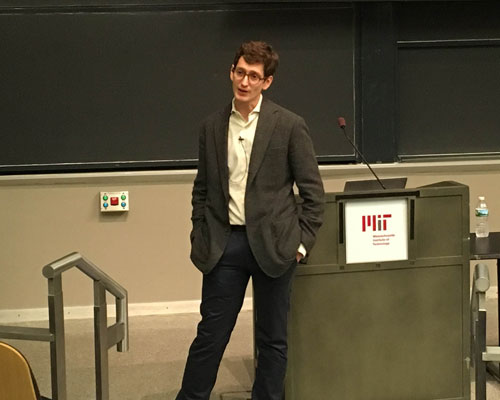R.Scott Kemp: Inside the Iran Deal

At a colloquium organized by the Department of Physics, R. Scott Kemp, the Norman C. Rasmussen Assistant Professor of Nuclear Science and Engineering, described the political strategizing and technical evaluations that went into crafting the Iran ‘nuclear deal’, and assessed its technical robustness.
Opening with a history of the negotiations leading up to the deal, Kemp explained that the election of Hassan Rouhani as the Iranian president in 2013 greatly improved the prospects for reopening dialog with Iran. Although, at this point, the US was desirous of setting in motion negotiations that could lead to a deal, the lack of reliable backchannels to Iranian leadership initially frustrated the possibility of starting negotiations. When the talks with Iran did begin, they marked the first negotiation with that country in decades (Rouhani’s phone call with Obama was the first conversation between the Heads of state of the two countries since 1979).
A central goal of the negotiations with Iran, which concluded in July 2015, was to extend the time it would take Iran to develop a weapon to one year. Indeed, when the Israeli Prime Minister, Benjamin Netanyahu made his speech before Congress in March 2015, Iran was less than a month away from being able to create a nuclear weapon, if it chose to do so.
The three key challenges that the negotiators faced, and ultimately worked to resolve, were the duration of the deal, the question of enrichment, and the heavy-water Arak reactor. Iran wished for a short, 2–3 year deal, retaining its enrichment capabilities, and preserving the Arak reactor. The reactor, which had been largely designed and built domestically and was seen as a national achievement, was a point of pride which the Iranian negotiators were loath to see dismantled or significantly altered. Ultimately, a deal with a duration of 15 years was struck, and it calls for a redesign of the Arak reactor in a manner that is minimally invasive to the original design but reduces its plutonium production by a factor of eight. The agreement also reduces the number of operational centrifuges, places a cap on the enrichment-level and quantity of enriched uranium held in Iran, and opens up all nuclear-related facilities to inspection.
Kemp’s evaluation of the deal is based on how it alters three plausible routes to a weapon: the plutonium route using spent fuel from the Arak reactor, the uranium route using the existing enrichment facilities, and a uranium route based on a clandestine facility. Ultimately, Kemp finds that although the duration of the deal is 15 years, the breakout time at the end of 11 years may have returned to a pre-deal level of about a month. However, despite the shortened breakout time, the provisions of the deal make it possible to readily detect activities towards developing a weapon, if they occur.
Thus, despite possible technical loopholes or oversights that the deal might contain, Kemp is a supporter of it. Last year in August, when the deal faced criticism in Congress, he helped lead the effort by 29 prominent US scientists in writing a letter to President Obama, praising the deal’s innovative approach to resolving a nonproliferation standoff. Kemp believes that the deal must be viewed in a broad context. He claims that an important and largely unsung benefit is that it leaves much of the pre-deal Iranian nuclear enterprise in place. This preserves the now well-established insights of various intelligence agencies, which he believes will help ensure that any clandestine activities, should they occur in the future, would be readily detected. Kemp concluded his remarks by saying that while Iran was previously motivated to create a nuclear weapon as a result of the Iraqi threats and intense political isolation, that threat is now gone, allowing Iran to step away from a weapons-like program. Thus, more than anything, the deal helps Iran’s motivation to stay nuclear-weapons-free by further opening up the country’s financial and political system to the rest of the world, and integrating its society regionally and internationally. With diligence, further integration could lay the ground to make a future deal altogether unnecessary.
Written by Aditi Verma
Photo by Aditi Verma
